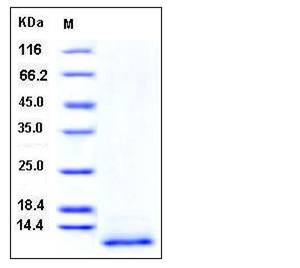Human CD9 / Tspan-29 Protein (His Tag)
BTCC-1,DRAP-27,MIC3,MRP-1,TSPAN-29,TSPAN29
- 100ug (NPP3720) Please inquiry
| Catalog Number | P11029-H08H |
|---|---|
| Organism Species | Human |
| Host | Human Cells |
| Synonyms | BTCC-1,DRAP-27,MIC3,MRP-1,TSPAN-29,TSPAN29 |
| Molecular Weight | The recombinant human CD9 consists of 95 amino acids and predictes a molecular mass of 11 kDa as estimated in SDS-PAGE under reducing conditions. |
| predicted N | Ser 112 |
| SDS-PAGE |  |
| Purity | > 95 % as determined by SDS-PAGE |
| Protein Construction | A DNA sequence encoding the second extracellular domain (Ser 112-Ile 195) of human CD9 (NP_001760.1) was fused with a polyhistidine tag at the C-terminus and a signal peptide at the N-terminus. |
| Bio-activity | |
| Research Area | Developmental Biology |Embryogenesis |Germ Layer Formation |Mesoderm Marker |
| Formulation | Lyophilized from sterile PBS, pH 7.4 1. Normally 5 % - 8 % trehalose and mannitol are added as protectants before lyophilization. Specific concentrations are included in the hardcopy of COA. |
| Background | The cluster of differentiation (CD) system is commonly used as cell markers in immunophynotyping. Different kinds of cells in the immune system can be identified through the surface CD molecules which associating with the immune function of the cell. There are more than 320 CD unique clusters and subclusters have been identified. Some of the CD molecules serve as receptors or ligands important to the cell through initiating a signal cascade which then alter the behavior of the cell. Some CD proteins do not take part in cell signal process but have other functions such as cell adhesion. CD9 is a member of the transmembrane 4 superfamily, which is also known as the tetraspanin family. CD9 is a cell surface glycoprotein with 4 hydrophobic domains that is described to complex with integrins and other transmembrane 4 superfamily members. It is found expressed on the surface of the exosomes. The protein takes part in cellular signal transduction events and thus play a role in the regulation of cell development and activation, growth and motility. Besides, CD9 seems to be a key role in the egg-sperm fusion during the mammalian fertilization processes. CD9 is found on the membrane of the oocytes and also appears to intervene in maintaining the normal shape of oocyte microvilli. |
| Reference |
